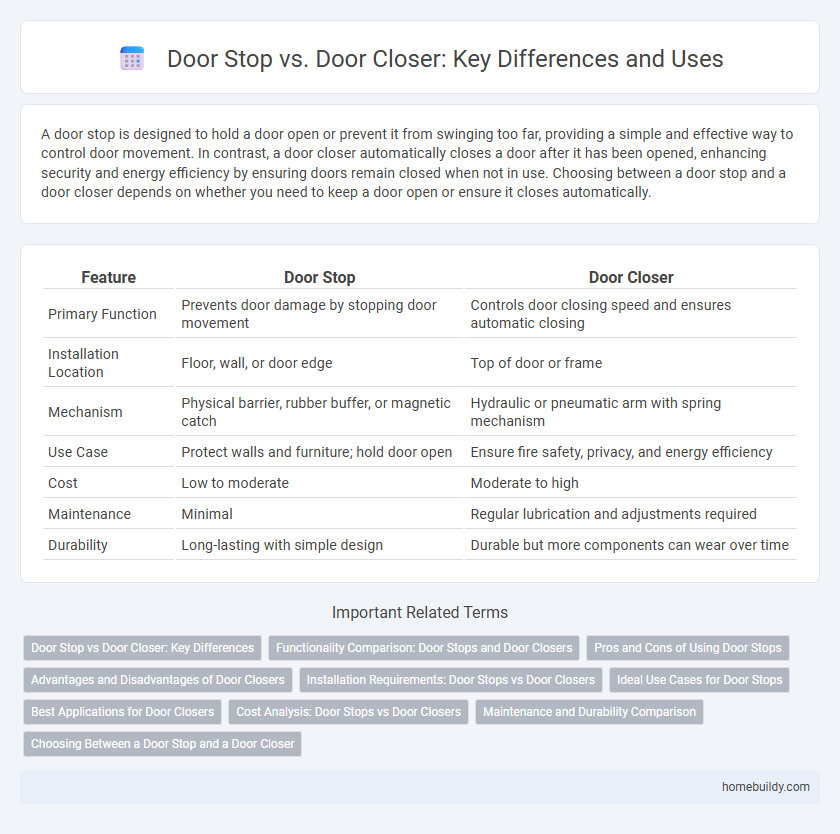A door stop is designed to hold a door open or prevent it from swinging too far, providing a simple and effective way to control door movement. In contrast, a door closer automatically closes a door after it has been opened, enhancing security and energy efficiency by ensuring doors remain closed when not in use. Choosing between a door stop and a door closer depends on whether you need to keep a door open or ensure it closes automatically.
Table of Comparison
| Feature | Door Stop | Door Closer |
|---|---|---|
| Primary Function | Prevents door damage by stopping door movement | Controls door closing speed and ensures automatic closing |
| Installation Location | Floor, wall, or door edge | Top of door or frame |
| Mechanism | Physical barrier, rubber buffer, or magnetic catch | Hydraulic or pneumatic arm with spring mechanism |
| Use Case | Protect walls and furniture; hold door open | Ensure fire safety, privacy, and energy efficiency |
| Cost | Low to moderate | Moderate to high |
| Maintenance | Minimal | Regular lubrication and adjustments required |
| Durability | Long-lasting with simple design | Durable but more components can wear over time |
Door Stop vs Door Closer: Key Differences
Door stops prevent doors from swinging too far, protecting walls and fixtures, while door closers control the door's closing speed and ensure it shuts securely to maintain security and energy efficiency. Door stops are typically simple devices like wedges or mounted buffers, whereas door closers are mechanical or hydraulic mechanisms installed at the top of the door. Understanding the key differences helps in selecting the right hardware for specific needs in both residential and commercial settings.
Functionality Comparison: Door Stops and Door Closers
Door stops primarily prevent doors from swinging too far and damaging walls or furniture by physically blocking their movement. Door closers, in contrast, automatically control the door's closing speed and ensure it shuts securely after opening, enhancing security and energy efficiency. While door stops offer basic protection against door damage, door closers provide advanced control over door operation, making them essential for commercial and high-traffic environments.
Pros and Cons of Using Door Stops
Door stops offer a simple and cost-effective solution for preventing doors from slamming or damaging walls, providing easy installation and minimal maintenance. Unlike door closers, door stops do not control the closing speed or automatic closure, which may lead to safety issues or energy inefficiency in maintaining indoor climate. Choosing door stops is ideal for temporary or light-use applications, while door closers better suit high-traffic areas requiring controlled door operation and enhanced security.
Advantages and Disadvantages of Door Closers
Door closers offer controlled door operation, improving security and energy efficiency by ensuring doors close automatically after opening. They reduce noise and prevent damage caused by doors slamming, but their installation requires more complexity and maintenance compared to simple door stops. However, door closers can be less accessible for people with disabilities and tend to be more expensive upfront than basic door stops.
Installation Requirements: Door Stops vs Door Closers
Door stops typically require minimal installation efforts, involving simple mounting on walls, floors, or baseboards with basic tools, making them accessible for DIY projects. Door closers demand more complex installation, often needing precise alignment and professional-grade hardware attached to the door and frame to ensure smooth operation and compliance with fire safety regulations. Understanding these installation differences helps in selecting the right device based on structural requirements and usage scenarios.
Ideal Use Cases for Door Stops
Door stops are ideal for preventing doors from damaging walls or furniture by limiting door movement in homes, offices, and public spaces. Unlike door closers, which automatically close doors for security and energy efficiency, door stops provide a simple, manual solution to keep doors open or in a fixed position. They are perfect for high-traffic areas where controlled door positioning is necessary without the need for automatic closing mechanisms.
Best Applications for Door Closers
Door closers are ideal for high-traffic commercial spaces, ensuring doors automatically close to maintain security, energy efficiency, and fire safety. They provide controlled closing speed and force, preventing door slams and reducing wear on hinges in office buildings, schools, and hospitals. Unlike door stops that merely hold doors open, door closers actively regulate door movement, making them essential for environments requiring strict access control and compliance with fire codes.
Cost Analysis: Door Stops vs Door Closers
Door stops typically cost between $5 and $20, offering an affordable solution for preventing door damage and securing doors in place. Door closers, on the other hand, range from $50 to over $200, reflecting their complex mechanism designed to automatically close doors and enhance security. Maintenance costs for door closers are generally higher due to mechanical parts requiring periodic adjustments and repairs, whereas door stops have minimal upkeep expenses.
Maintenance and Durability Comparison
Door stops require minimal maintenance with occasional cleaning and checking for wear, making them durable for long-term use without complex servicing. Door closers consist of mechanical parts like springs and hydraulic systems that need regular adjustments and lubrication to maintain proper functionality and extend lifespan. The simple design of door stops generally results in greater durability and fewer maintenance demands compared to the more intricate and maintenance-intensive door closers.
Choosing Between a Door Stop and a Door Closer
Choosing between a door stop and a door closer depends on controlling door movement and preventing damage; door stops effectively hold doors open or prevent them from hitting walls, while door closers regulate the door's closing speed and ensure it closes securely. Door stops are simpler and cost-effective for basic needs, but door closers offer enhanced security, energy efficiency, and accessibility compliance. Evaluate the specific requirements of door control, such as safety, convenience, and building codes, before selecting the appropriate device.
door stop vs door closer Infographic

 homebuildy.com
homebuildy.com